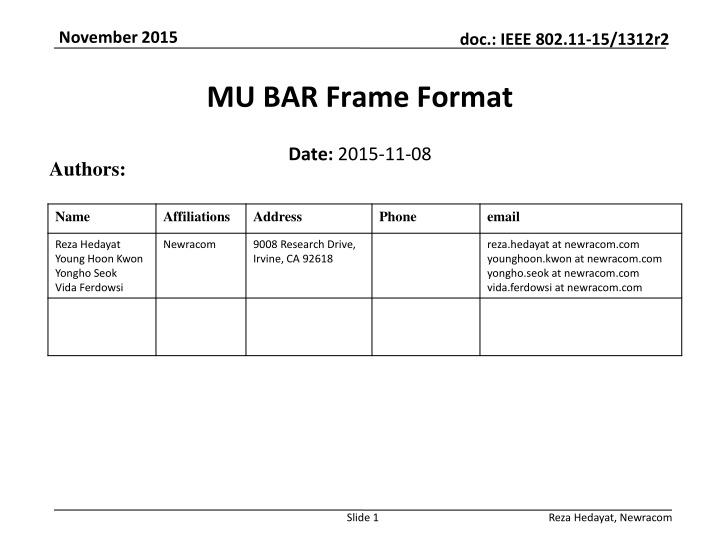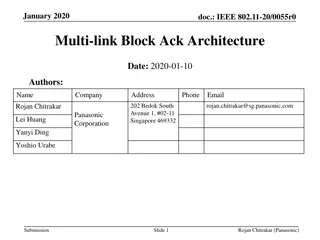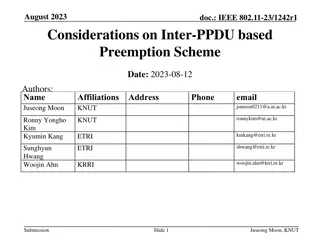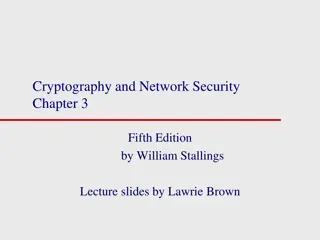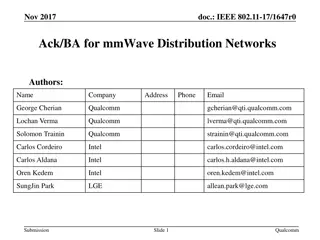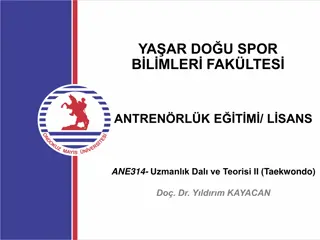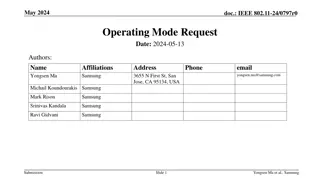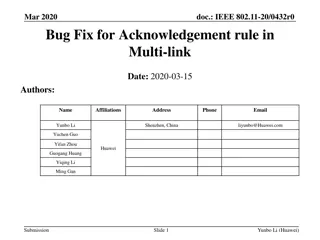IEEE 802.11-15/1312r2 Multiuser Block ACK Request Format
In November 2015, a document was presented regarding the format of the Multiuser Block ACK Request (MU BAR) frame in IEEE 802.11-15/1312r2. The document outlines the purpose of the MU BAR frame to solicit BA/ACK frames in uplink MU transmissions, providing different options for the frame format and discussing their pros and cons.
Download Presentation

Please find below an Image/Link to download the presentation.
The content on the website is provided AS IS for your information and personal use only. It may not be sold, licensed, or shared on other websites without obtaining consent from the author.If you encounter any issues during the download, it is possible that the publisher has removed the file from their server.
You are allowed to download the files provided on this website for personal or commercial use, subject to the condition that they are used lawfully. All files are the property of their respective owners.
The content on the website is provided AS IS for your information and personal use only. It may not be sold, licensed, or shared on other websites without obtaining consent from the author.
E N D
Presentation Transcript
November 2015 doc.: IEEE 802.11-15/1312r2 MU BAR Frame Format Date: 2015-11-08 Authors: Name Affiliations Address Phone email Reza Hedayat Young Hoon Kwon Yongho Seok Vida Ferdowsi Newracom 9008 Research Drive, Irvine, CA 92618 reza.hedayat at newracom.com younghoon.kwon at newracom.com yongho.seok at newracom.com vida.ferdowsi at newracom.com Slide 1 Reza Hedayat, Newracom
November 2015 doc.: IEEE 802.11-15/1312r2 Outline In past meetings, the TGax passed the following MU motions: 802.11ax amendment shall include a mechanism to multiplex BA/ACK responses to DL MU transmission The spec shall define a MU-BAR frame to solicit BA/ACKs from multiple STAs in UL MU transmissions. The amendment shall include a mechanism to multiplex acknowledgment frames in response to Multicast receptions under GCR BA operation. In this contribution three options for MU BAR frame format is presented and pros and cons of above options will be discussed Slide 2 Reza Hedayat, Newracom
November 2015 doc.: IEEE 802.11-15/1312r2 Multiuser Block-ACK Request Multiuser Block-ACK Request (MU BAR) solicits BA or ACK frames from STAs to be multiplexed in an uplink MU transmissions [15/1053] MU BAR solicit ACK/BA frames similar to a DL MU frame DL MU MU-BAR AP BA STA1 BA STA2 BA STA3 BA STA4 Slide 3 Reza Hedayat, Newracom
November 2015 doc.: IEEE 802.11-15/1312r2 Multiuser Block-ACK Request MU BAR solicits ACK/BA frames in other ways too: An MU BAR frame can solicit ACK/BA frames for payloads that were previously delivered either in SU and/or MU PPDUs An MU BAR frame can solicit ACK/BA frames for payloads that were delivered in a multicast service Multicast frame MU-BAR AP BA STA1 BA STA2 Slide 4 Reza Hedayat, Newracom
November 2015 doc.: IEEE 802.11-15/1312r2 MU BAR Frame Format - 1 The first option for MU BAR frame format is to modify a multi-TID BAR frame so that it acts as a Trigger frame The following is the structure of multi-TID BAR Slide 5 Reza Hedayat, Newracom
November 2015 doc.: IEEE 802.11-15/1312r2 MU BAR Frame Format - 1 Similar to multi-TID BA that was adopted by 11ax SFD as multi-STA BA, multi-TID BAR can be used as multi-STA BAR Similar change to Per-TID info can be made to accommodate each STA AID Moreover, the following sub-fields is added to convey the scheduling info so that each STA can participate in the following UL MU PPDU: Added to BAR information field for each STA RU indication subfield MCS subfield Added to BAR Control field LTF length indication subfield GI indication subfield Slide 6 Reza Hedayat, Newracom
November 2015 doc.: IEEE 802.11-15/1312r2 MU BAR Frame Format - 1 MU BAR Control MU BAR Information AID, RU Index, MCS, GI indication, LTF indication, Repeat for each STA Pros and cons of option 1 Since the content of BAR/Trigger frames are combined, it avoids fields duplications This option proposes a new control frame and a new sub-type is required Slide 7 Reza Hedayat, Newracom
November 2015 doc.: IEEE 802.11-15/1312r2 MU BAR Frame Format - 2 The second option for MU BAR frame format is to aggregate a Trigger frame with a multi-TID BAR Trigger frame has been adopted in 11ax SFD to trigger responses from multiple STAs within a UL MU frame Trigger Frame Multi-STA(TID) BAR FC Duration (A1) A2 Common Info Per-STA Info Per-STA Info FCS Slide 8 Reza Hedayat, Newracom
November 2015 doc.: IEEE 802.11-15/1312r2 MU BAR Frame Format - 2 A STA that receives multi-STA (multi-TID) BAR with one AID matching the AID of the STA shall respond with a BA frame after TBD IFS if the same PPDU carries a Trigger frame with a matching AID in a per-user info field of the Trigger frame Pros and cons of option 2 Due to aggregation of two frames, each receiving STA need to process two frames to be able to respond with BA. If either of the two frames are not decoded successfully then there is no chance to respond with the BA frame Due to aggregation of two frames, a lot of fields are duplicated. Particularly, the AID for each STA (that is expected to send a BA frame in response to the MU BAR) is repeated in both Trigger frame and multi-TID BAR frame Slide 9 Reza Hedayat, Newracom
November 2015 doc.: IEEE 802.11-15/1312r2 Trigger Frame Trigger frame in 11ax SFD: a new control frame format that carries sufficient information to identify the STAs transmitting the UL MU PPDUs and allocating resources for the UL MU PPDUs. Trigger frame has the following additional fields: Common Info, Per-User Info (one for each resource allocation) [15/877] FCS FC Duration (A1) A2 Common Info Per-STA Info Per-STA Info Trigger frame might be used for various purposes For instance, a Trigger frame can be used to poll several STAs to send buffer status report [15/1120] Or a Trigger frame can be used to poll several STAs to send BA frames Therefore, a Trigger frame can carry a Trigger Type subfield where it indicates the purpose of the Trigger frame Slide 10 Reza Hedayat, Newracom
November 2015 doc.: IEEE 802.11-15/1312r2 MU BAR Frame Format - 3 The third option for MU BAR frame format is to use a Trigger frame that has additional sub-fields necessary for BAR Trigger frame with type MU BAR can carries the following subfields: BAR Info (Block ACK Starting Sequence Number) in each per-STA info BAR Control (TBD content and size) in the Common Info field Not all the subfields in the current BAR Control field may be present in MU BAR. E.g., BAR ACK policy need not be present since all the participating STAs are expected to respond with BA right after the MU BAR frame. FC Duration (A1) A2 Common Info Per-STA Info Per-STA Info FCS Duration, GI indication, LTF indication Trigger Type = BAR, BAR Control (TBD) AID, RU index, MCS, BAR Information Slide 11 Reza Hedayat, Newracom
November 2015 doc.: IEEE 802.11-15/1312r2 MU BAR Frame Format - 3 Pros and cons of option 3 A recipient STA need to decode a single frame to be able to participate in the following UL MU frame The use of Trigger Type gives a structure to use Trigger frame for various purposes such as MU BAR FC Duration (A1) A2 Common Info Per-STA Info Per-STA Info FCS Duration, GI indication, LTF indication Trigger Type = BAR, BAR Control (TBD) AID, RU index, MCS, BAR Information Slide 12 Reza Hedayat, Newracom
November 2015 doc.: IEEE 802.11-15/1312r2 Conclusion MU BAR recently was added to 11ax SFD. MU BAR solicits multiplexed ACK/BA frames several ways: (a) for payloads that were delivered either in SU and/or MU PPDUs, (b) for payloads that were delivered in a multicast service In this contribution three options for MU BAR format was proposed Considering the pros and cons of the three options, it seems that a Trigger frame with type BAR suits best to be used for MU BAR frame format Slide 13 Reza Hedayat, Newracom
November 2015 doc.: IEEE 802.11-15/1312r2 Strawpoll Do you agree the following to be added to 11ax SFD: 7.2.X: The MU BAR frame is a Trigger frame whose Trigger Type subfield is MU BAR that carries additional BAR Control subfield (TBD) and an additional BAR Information subfield (TBD) in Common Info and/or each Per-User info. Slide 14 Reza Hedayat, Newracom
